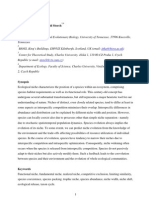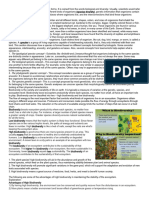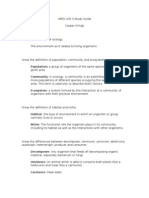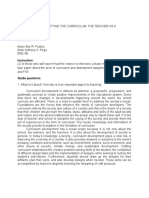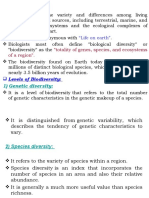Name: Mark Anthony A. Pega BSE-3B
Name: Mark Anthony A. Pega BSE-3B
Uploaded by
Mark Anthony Alehandre PegaCopyright:
Available Formats
Name: Mark Anthony A. Pega BSE-3B
Name: Mark Anthony A. Pega BSE-3B
Uploaded by
Mark Anthony Alehandre PegaOriginal Description:
Original Title
Copyright
Available Formats
Share this document
Did you find this document useful?
Is this content inappropriate?
Copyright:
Available Formats
Name: Mark Anthony A. Pega BSE-3B
Name: Mark Anthony A. Pega BSE-3B
Uploaded by
Mark Anthony Alehandre PegaCopyright:
Available Formats
Name: Mark Anthony A.
Pega BSE-3B
1. How the concept of niche was developed?
The definition of a niche has changed since it was first introduced. A field biologist
named Joseph Grinnell took the basic concept of the niche and further developed it, claiming
that a niche distinguished between different species that occupied the same space. In other
words, only one species could have a particular niche. He was influenced by species
distribution. Ecologist Charles Elton’s definition of niche focused on the role of a species, such
as its trophic role. His tenets emphasized more on community similarity and less on competition.
In 1957, Zoologist G. Evelyn Hutchinson provided a sort of compromise of these trains of
thought. Hutchinson described two forms of niche. The fundamental niche focused on the
conditions in which a species could exist with no ecological interactions. The realized niche, in
contrast, considered the population’s existence in the presence of interactions, or competition.
The adoption of the ecological niche concept has allowed ecologists to understand the roles of
species in ecosystems.
2. How would you compare specialized from generalized niche? Give examples
Specialized niche is apply for those species which have a very well-defined or narrow
physical, biological or chemical requirements for survival which means they have a narrow niche
which is specific and limited and one the example of species for this kind of niche are the giant
pandas, also known as specialist with a narrow ecological niche while generalized niche is apply
to a species which can exist in a broad range of conditions and humans are considered as the
best example of species with a generalized niche. Compare with specialized niche they have a
broad niche wherein they can able to withstand numerous conditions.
3. Discuss competitive exclusion principle.
The competitive exclusion principle sometimes referred to as Gause’s Law of
competitive exclusion or just Gause’s Law, tells us that two species can’t have exactly the same
niche in a habitat and stably coexists. That's because species with identical niches also have
identical needs, which means they would compete for precisely the same resources. One of the
two competitors will always have an ever so slight advantage over the other that leads to
extinction of the second competitor in the long run (in a hypothetical non-evolving system) or (in
the real world) to an evolutionary shift of the inferior competitor towards a different ecological
niche. As a consequence, competing related species often evolve distinguishing characteristics
in areas where they both coexist. This aids in mate recognition, thus maintaining each species'
superiority in exploiting slightly different ecological niches.
4. What are the 2 most common communities? give the detailed information.
Community, also called biological community, in biology, an interacting group of various
species in a common location. For example, a forest of trees and undergrowth plants, inhabited
by animals and rooted in soil containing bacteria and fungi, constitutes a biological community.
Among the factors that determine the overall structure of a community are the number of
species (diversity) within it, the number of each species (abundance) found within it, the
interactions among the species, and the ability of the community to return to normal after a
disruptive influence such as fire or drought. The change of biological communities over time
is2known as succession, or ecological succession.2
The various species in a community each occupy their own ecological niche. The niche
of a species includes all of its interactions with other members of the community, including
competition, predation, parasitism, and mutualism. The organisms within a community can be
positioned along food chains by showing which eats which, and these positions are known as
trophic levels. The first level includes the producerswhich convert the Sun’s radiant energy into
nutrients available to other organisms in the community. These plants are eaten by herbivores,
the second trophic level. Herbivores are, in turn, eaten by carnivores, which are frequently eaten
by larger carnivores. The food chain ends when the last link dies and is attacked by various
bacteria and fungi, the decomposers that break down dead organic matter and thereby release
essential nutrients back into the environment.2
You might also like
- Lesson 5.1 Worksheets (1) COMPLETEDocument6 pagesLesson 5.1 Worksheets (1) COMPLETEBrianna Dominguez43% (7)
- MT1 - Evolution, Biological Communities, and Species InteractionsDocument9 pagesMT1 - Evolution, Biological Communities, and Species InteractionsRose Guillian Cabigan100% (1)
- Community CharacteristicsDocument6 pagesCommunity CharacteristicsChristine ApriyaniNo ratings yet
- The Unified Neutral Theory of Biodiversity and BiogeographyFrom EverandThe Unified Neutral Theory of Biodiversity and BiogeographyRating: 5 out of 5 stars5/5 (1)
- Biodiversity and Earth History - Boenigk, Wodniok, GlücksmanDocument410 pagesBiodiversity and Earth History - Boenigk, Wodniok, GlücksmanSantiago Infante100% (4)
- Various Methods of SamplingDocument9 pagesVarious Methods of SamplingAhmad Ali100% (1)
- mODULE 3Document33 pagesmODULE 3Michael Clinton DionedaNo ratings yet
- Combined-Lecture-Note-BIO101-2Document22 pagesCombined-Lecture-Note-BIO101-2irememmanuel78No ratings yet
- CPR - Chapter 1Document17 pagesCPR - Chapter 1bascobrixivan1No ratings yet
- 4 - Ecological Niche 811Document20 pages4 - Ecological Niche 811Ariane Santiago100% (1)
- Sir Aian MidtermDocument6 pagesSir Aian MidtermEl TigreNo ratings yet
- 26c726baf1e7dfa5ce3042460e04360cDocument11 pages26c726baf1e7dfa5ce3042460e04360cAaryan MoreNo ratings yet
- Group 2 - Habitat and NicheDocument22 pagesGroup 2 - Habitat and NicheYudha OkpriandaNo ratings yet
- Basic Ecological ConceptsDocument43 pagesBasic Ecological ConceptsEJ David Beltran100% (1)
- Cortez Manuscript Lesson 10Document3 pagesCortez Manuscript Lesson 10Rola, Honey DaneNo ratings yet
- Ecological NicheDocument3 pagesEcological NicheBiju ThomasNo ratings yet
- Biology and EcologyDocument5 pagesBiology and EcologykarennNo ratings yet
- Biodiversity Has Emerge As A Scientific Topic With A High Degree of Social Prominence and Consequently of Political ImportantDocument5 pagesBiodiversity Has Emerge As A Scientific Topic With A High Degree of Social Prominence and Consequently of Political ImportantFatin SakuraNo ratings yet
- HAND-OUT - Community EcologyDocument4 pagesHAND-OUT - Community EcologyBello NelsonNo ratings yet
- Science 8 Handouts m5m6Document2 pagesScience 8 Handouts m5m6Rizel Manlapas FernandezNo ratings yet
- SZL202 Topic One Components of An EcosystemDocument5 pagesSZL202 Topic One Components of An Ecosystemmarubegeoffrey41No ratings yet
- Chaprter 4 Environmental ScienceDocument8 pagesChaprter 4 Environmental Sciencejeboy DaquizNo ratings yet
- Biotic Community ConceptDocument2 pagesBiotic Community Conceptmichaeluriel100% (2)
- Competition among organismsDocument9 pagesCompetition among organismsRogers OmurwaNo ratings yet
- Community EcologyDocument7 pagesCommunity EcologyRazia KanwalNo ratings yet
- AGA1101 ECOLOGY September 2024Document27 pagesAGA1101 ECOLOGY September 2024kieshapaddeNo ratings yet
- B 10 VRV 2042Document36 pagesB 10 VRV 2042api-283593849No ratings yet
- Organic FoodDocument10 pagesOrganic FoodJitto John VijiNo ratings yet
- ESS Assessment Prep PDFDocument7 pagesESS Assessment Prep PDFareenaNo ratings yet
- Science 9 NotesDocument26 pagesScience 9 Notesmarialuciocabrera353No ratings yet
- SZL202 Topic Two Habitat and NicheDocument5 pagesSZL202 Topic Two Habitat and Nichemarubegeoffrey41No ratings yet
- Interactions in EcosystemsDocument42 pagesInteractions in EcosystemsJeanelle AlbertNo ratings yet
- Living Things and Their EnvironmentDocument3 pagesLiving Things and Their EnvironmentVergzMonch EspielNo ratings yet
- Ecology Review NotesDocument6 pagesEcology Review NotesMaKylah ClevelandNo ratings yet
- Lecture 6 Part 1 Plant EcologyDocument57 pagesLecture 6 Part 1 Plant EcologyChala KelbessaNo ratings yet
- Biology Notes (TB)Document8 pagesBiology Notes (TB)ChamsNo ratings yet
- Edit ItDocument15 pagesEdit ItAkahi GabrielNo ratings yet
- 3.0 Community InteractionDocument95 pages3.0 Community InteractionAT4-11 HUMSS 2 CEDRICK ILAONo ratings yet
- Presentation Ecology Submitted by 22 23 25 26 27 28.......Document27 pagesPresentation Ecology Submitted by 22 23 25 26 27 28.......lodhiirfNo ratings yet
- Concept of Population and Community EcologyDocument2 pagesConcept of Population and Community Ecologyasmitamahajan1502No ratings yet
- Organisms InteractionDocument3 pagesOrganisms InteractionMary Ylane LeeNo ratings yet
- Ecology, Its Scope, Its Methods, Its GoalsDocument13 pagesEcology, Its Scope, Its Methods, Its GoalsAbdul GhaffarNo ratings yet
- Interactions in The BiosphereDocument8 pagesInteractions in The BiosphereGodwayneNo ratings yet
- Ecological Concepts and Principle - Q1W2-3Document38 pagesEcological Concepts and Principle - Q1W2-3kimberly.sulitNo ratings yet
- 0039Autecology-and-Synecology-organisation-limiting-factorDocument8 pages0039Autecology-and-Synecology-organisation-limiting-factorNikola TeslaNo ratings yet
- APES Unit 3 Study GuideDocument5 pagesAPES Unit 3 Study GuideCooper KringsNo ratings yet
- Population Interaction:: CompetitionDocument19 pagesPopulation Interaction:: CompetitionRe HanaNo ratings yet
- Lecture 12 - B4501-Advanced Ecology - 2024-2025Document5 pagesLecture 12 - B4501-Advanced Ecology - 2024-2025Khauhelo bernard LechesaNo ratings yet
- Principles of Ecology (1)Document17 pagesPrinciples of Ecology (1)nbaidya58No ratings yet
- Community EcologyDocument4 pagesCommunity EcologyBiju ThomasNo ratings yet
- EED 4118 Lesson 1Document5 pagesEED 4118 Lesson 1KevinNo ratings yet
- Autecology Is The Ecology of A Single SpeciesDocument23 pagesAutecology Is The Ecology of A Single SpeciesmaygracedigolNo ratings yet
- Sci7 Studytnotes Jan. 16,2023-Science7Document4 pagesSci7 Studytnotes Jan. 16,2023-Science7lucky laguraNo ratings yet
- Environmental ScienceDocument42 pagesEnvironmental Scienceashadkhan1000No ratings yet
- The Basic Ecological Concepts 2 Lecture NotesDocument3 pagesThe Basic Ecological Concepts 2 Lecture NotesJustin ProvedenciaNo ratings yet
- Taxonomy PDFDocument15 pagesTaxonomy PDFSwarup MondalNo ratings yet
- Topic 8. Evolution Biological Communities and Species InteractionsDocument15 pagesTopic 8. Evolution Biological Communities and Species Interactions科琳No ratings yet
- Sci8-Q4-MODULE 4-WEEK 4Document8 pagesSci8-Q4-MODULE 4-WEEK 4Jene kristel ManabatNo ratings yet
- Reflection 2 - Ge15Document1 pageReflection 2 - Ge15Joy MagbutongNo ratings yet
- 20170615.110830.332-Ecological Niche 811 NewRevisionDocument22 pages20170615.110830.332-Ecological Niche 811 NewRevisionImad BenaliNo ratings yet
- The Web of Life: Understanding Ecology and Our Place in ItFrom EverandThe Web of Life: Understanding Ecology and Our Place in ItNo ratings yet
- Believe You Can: and You're Halfway ThereDocument5 pagesBelieve You Can: and You're Halfway ThereMark Anthony Alehandre PegaNo ratings yet
- Name: Mark Anthony A. Pega Year and Section: Bse 3B DATE: 08-13-19 Score: Explain How COMPLETE and INCOMPLETE COMBUSTION of Gasoline in CarsDocument7 pagesName: Mark Anthony A. Pega Year and Section: Bse 3B DATE: 08-13-19 Score: Explain How COMPLETE and INCOMPLETE COMBUSTION of Gasoline in CarsMark Anthony Alehandre PegaNo ratings yet
- Prehistoric Era: 10 Million Years AgoDocument8 pagesPrehistoric Era: 10 Million Years AgoMark Anthony Alehandre PegaNo ratings yet
- Trends, Networks, & Critical Thinking in The 21St Century: Christine Diane Galvan InstructressDocument19 pagesTrends, Networks, & Critical Thinking in The 21St Century: Christine Diane Galvan InstructressMark Anthony Alehandre PegaNo ratings yet
- Carbohydrates: Carbohydrates Are Large Class of Naturally Occurring Polyhydroxy Aldehyde and KetoneDocument14 pagesCarbohydrates: Carbohydrates Are Large Class of Naturally Occurring Polyhydroxy Aldehyde and KetoneMark Anthony Alehandre PegaNo ratings yet
- FS 4 EssayDocument2 pagesFS 4 EssayMark Anthony Alehandre PegaNo ratings yet
- FS 5 EssayDocument2 pagesFS 5 EssayMark Anthony Alehandre PegaNo ratings yet
- CHACHIDocument1 pageCHACHIMark Anthony Alehandre PegaNo ratings yet
- CHACHIDocument1 pageCHACHIMark Anthony Alehandre PegaNo ratings yet
- Roger Leroy MillerDocument1 pageRoger Leroy MillerMark Anthony Alehandre PegaNo ratings yet
- Effectiveness of Baking SodaDocument22 pagesEffectiveness of Baking SodaMark Anthony Alehandre PegaNo ratings yet
- BiodiversityDocument19 pagesBiodiversityGill0% (1)
- A Revision of Aleurodicus Douglas With Two New Genera Proposed For Paleotropical Natives An Identification Guide To World GeneraDocument100 pagesA Revision of Aleurodicus Douglas With Two New Genera Proposed For Paleotropical Natives An Identification Guide To World GeneraJulian LeonardoNo ratings yet
- Phylogenomics Reveals The Evolution, Biogeography, and Diversi Fication History of Voles in The Hengduan MountainsDocument12 pagesPhylogenomics Reveals The Evolution, Biogeography, and Diversi Fication History of Voles in The Hengduan MountainsEmilio VarColNo ratings yet
- Lab 4 - DNA Barcoding and Extraction PDFDocument9 pagesLab 4 - DNA Barcoding and Extraction PDFMary TaklaNo ratings yet
- Dr. B. VictorDocument29 pagesDr. B. VictorBnr GoudNo ratings yet
- In Situ Conservation: ES - Biodiversity and Wildlife ConservationDocument38 pagesIn Situ Conservation: ES - Biodiversity and Wildlife ConservationJaffy BustamanteNo ratings yet
- Environmental Systems and Societies Paper 3 SL MarkschemeDocument12 pagesEnvironmental Systems and Societies Paper 3 SL MarkschemeAfra LamisaNo ratings yet
- Biodiversity HotspotsDocument6 pagesBiodiversity Hotspotsroopalmishra98No ratings yet
- CULTUREDocument4 pagesCULTUREApril MataloteNo ratings yet
- Reproductive Isolation and Speciation Updated For ApDocument25 pagesReproductive Isolation and Speciation Updated For Apapi-265142071No ratings yet
- Readings On Life and Nature NotesDocument29 pagesReadings On Life and Nature NoteslayaptxcNo ratings yet
- Homework 2024 C6 - 3BDocument7 pagesHomework 2024 C6 - 3ByanhcharlieNo ratings yet
- ELS Systematics-Week7Document60 pagesELS Systematics-Week7wenshylavador7No ratings yet
- STS Reviewer For FinalsDocument18 pagesSTS Reviewer For FinalsMoreno MJNo ratings yet
- Monograph 1Document1 pageMonograph 1Atashi MandalNo ratings yet
- Phabsim ManualDocument299 pagesPhabsim ManualSergei HGNo ratings yet
- Biologia Molecular de PseudomonasDocument528 pagesBiologia Molecular de PseudomonasW Antonio Muñoz ChNo ratings yet
- Assignment 2 Ecology and EvolutionDocument5 pagesAssignment 2 Ecology and EvolutionpatrasNo ratings yet
- Biology Investigatory ProjectDocument17 pagesBiology Investigatory ProjectAnuj Kamble100% (7)
- Science Quarter 4 - Week 2 Hint of Evolution From Comparative Anatomy Grade 10A1, A2, A3, A4, B, CDocument3 pagesScience Quarter 4 - Week 2 Hint of Evolution From Comparative Anatomy Grade 10A1, A2, A3, A4, B, CAnna Marie ErapNo ratings yet
- BT201 - Grand Quiz (Midterm)Document15 pagesBT201 - Grand Quiz (Midterm)dr amjadNo ratings yet
- Bateson Feenders 2010Document15 pagesBateson Feenders 2010VivitoNo ratings yet
- Chap 22Document79 pagesChap 22karen milloNo ratings yet
- Gaines Et Al. 1999. Monitoring Biodiversity Quantification and InterpretationDocument36 pagesGaines Et Al. 1999. Monitoring Biodiversity Quantification and InterpretationJCNo ratings yet
- SAT Suite Question Bank - 10 (FK U)Document37 pagesSAT Suite Question Bank - 10 (FK U)Ananta BasnetNo ratings yet
- Assessment of Insect BiologicalDocument123 pagesAssessment of Insect BiologicalMAIRA ALEJANDRA GONZALEZ SANCHEZNo ratings yet









